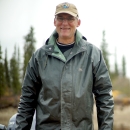Selawik Refuge has one long-term alpine vegetation monitoring site in the Hockley Hills, part of the international Global Observation Research Initiative in Alpine Environments (GLORIA) project.
In 2006, Selawik refuge was accepted as an observation site within a worldwide monitoring network studying the effect of climate change climate change
Climate change includes both global warming driven by human-induced emissions of greenhouse gases and the resulting large-scale shifts in weather patterns. Though there have been previous periods of climatic change, since the mid-20th century humans have had an unprecedented impact on Earth's climate system and caused change on a global scale.
Learn more about climate change on high mountain environments. This allow the study of impacts caused by climate change without or with minimal masking effects caused by human activities and thus can be more accurately assessed for ecological consequences related to climate change. Most of the network’s 47 observation sites are located in Europe; Selawik refuge is the first GLORIA site in the North American Arctic. The site was established in the Hockley Hills in 2007 and will be revisited periodically. Selawik Refuge will work with US Fish & Wildlife Service botanists and others to continue the GLORIA project in the long term.



